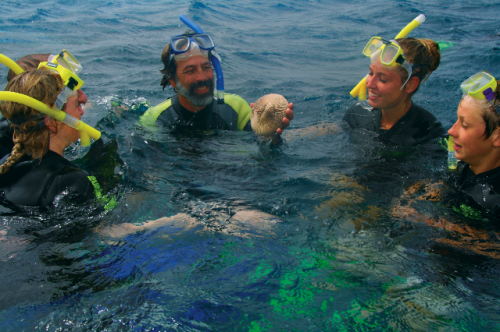By Sarah Sekula, published on tripatlas.com
As a 6-year-old, John Scotese took his first scuba diving excursion in the cold, cloudy waters of Lake Michigan. There, he caught a glimpse of one fish. Fast forward several decades and things have changed, indeed. These days, as a marine biologist for Quicksilver Cruises Reef Biosearch, he swims alongside swarms of bright-yellow angelfish, leopard moray eels and carpet sharks. His office, the Great Barrier Reef, is a 1,250-mile-long playground where he sees something new every day. I caught up with him recently for the low down on what it’s like working on the world’s single largest coral domain.
Most interesting day on the job?
Once, we encountered a very large hammerhead shark while doing a drift snorkel. Everyone remained calm, and he came right up to us; I could have touched him, he was that close. Just a few days ago we saw Migaloo, the only known white humpback whale in the world. I’ve also encountered pods of dolphins many times. They are very curious creatures and they will come to check you out, several at a time, until each one has a turn. Sometimes large barracuda will come and stare you right in the eye while snorkeling. On the other hand, most of the sharks we encounter are under 5 feet long and rather shy of humans. The ultimate experience, of course, is snorkeling and diving with whales. Even though there are strict legal guidelines in Australia for such activities, the whales seem to have no concern for the law when it comes to swimming with humans. Quicksilver Connections has many moorings where there are chance encounters with humpback and minke whales during our winter months. They are like dolphins, curious, but do not really want to know us.
How do you teach others to preserve and protect the GBR?
Locally, the Great Barrier Reef Marine Park Authority (GBRMPA) manages the park and implements policies aimed toward sustainability in tourism, fisheries and coastal management. It is my hope that the people who come to visit the reef appreciate the fact that it is a World Heritage Listed Site, and that we should do all within our power to pass this wonder of nature onto future generations. On a global level, we need to look at the way we manage and consume energy and renewable resources. Basically, we have to make a major shift on this front, as one of the casualties expected from climate change will manifest in loss of coral reefs.

Strangest creatures?
I like the guitar fish; it is a cartilaginous fish and is best described as a cross between a shark and a ray. Cuttlefish are interesting; they pretend they do not see you, but they are very much aware and flash different colors as you approach. The humphead maori wrasse, with a humpy head and tattoos on its face, is really interesting. They are rather friendly and act like dogs and seem to enjoy encounters with humans, especially if you feed them. Then there is the buffalo fish, the world’s largest parrot fish. They also have a big hump on their head and huge beaks, which they use to eat the coral like biscuits.
What’s life like in Queensland (www.visit-queensland.com)?
I have been a nature lover ever since I was a kid — exploring forest, fields, streams and ponds to see what kind of life forms I could find. When I’m not working, I enjoy beach combing, as it is very meditative. On a hot summer day there is nothing better than taking Silver Sonic out to the Agincourt Reefs on a glass-out day for diving and snorkeling. I also enjoy volunteering for the annual beach clean up.
Name some of the endangered species living in the GBR. What is being done to protect them?
Just to name a few, the humphead maori wrasse is now fully protected and can no longer be fished. Australia continues to press for a whale sanctuary in the Southern Ocean to protect the humpback and minke whales that visit the GBR during the winter months. Turtle sanctuaries and breeding programs have been implemented to protect declining turtle stocks. Also, seven years ago, the GBRMPA increased the area of Marine National Parks from 4 percent to 34 percent. Quicksilver Connections has several pontoons and over 40 moorings within our local Green Zones off of Port Douglas and Cairns. We encounter many local resident endangered animals in our areas and fish stocks overall have increased, so the Green Zones appear to be working well.
